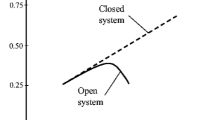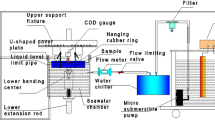Abstract
The practice of the determination of cyclic crack resistance, i.e., the rate of fatigue crack growth depending on the range of the stress intensity factor, has existed for more than a decade. However, a number of problems related to the use of these data for the quantitative assessment of the service life for deep-sea equipment remain poorly understood. They are description of crack kinetics under alternating and mainly compressive loading cycles and taking into account the possible impact of differences in loading frequency for a sample and for a structure in corrosive media. The investigation of the impact of these factors is performed using a technique for monitoring the changes in the compliance of a sample, which allows one to register the loads of crack opening and complete closing and crack propagation at small temporal bases under testing with reduction of the frequency to 0.01 Hz.
Similar content being viewed by others
References
DNV-RP-C203. Fatigue Design of Offshore Steel Structures, Oslo: Det Norske Veritas, 2011.
Det Norske Veritas/Classification Notes DNV-CN30-7 “Fatigue Assessment of Ship Structures”, Oslo: Det Norske Veritas, 2010.
BS 7608:1993: Code of Practice for Fatigue Design and Assessment of Steel Structures.
ISO 19902:2007: Petroleum and Natural Gas Industries Fixed Steel Offshore Structures.
Hobbacher, A., Recommendations for fatigue design of welded joints and components, in Document XIII-2151R1-07/XV-1254R1–07, Villepinte: Int. Inst. Welding, 2007.
Eurocode 3: Design of Steel Structures. Part 1–9: Fatigue.
Srivastava, V. and Sridhar, K., Corrosion fatigue crack growth and threshold stress intensity factors of shipbuilding steel, Proc. of Navy and Shipbuilding Nowadays (NSN’2011), St. Petersburg, Russia, June 30–July 1, 2011.
BS 7910:2005: Guide to Methods for Assessing Acceptability of Flaws in Metallic Structures.
ASME Boiler and Pressure Vessel Code. Section XI. Rules for In-service Inspection of Nuclear Power Plant Components, New York: Am. Soc. Mech. Eng., 2015.
Nigmatulin, V.I., Palii, O.M., and Rybakina, O.G., Experimental evaluation of the effect of compressive stresses on cyclic crack resistance of structural materials, Tr. Krylovskogo Gos. Nauch. Tsentra, 2013, no. 75 (359), pp. 61–68.
BS ENISO 11782: Part 2. Corrosion of Metals and Alloys Corrosion Fatigue Testing. Crack Propagation Testing Using Pre-Cracked Specimens, 2008.
ASM Handbook, Vol. 19: Fatigue and Fracture, New York: Am. Soc. Mech. Eng., 1996.
Knop, M., Health, J., Sterjovski, Z., and Lynch, S.P., Effects of cycle frequency on corrosion-fatigue crack growth in cathodically protected high strength steels, Proc. Eng., 2010, vol. 2, pp. 1243–1252.
Author information
Authors and Affiliations
Corresponding author
Additional information
Original Russian Text © K.E. Sadkin, A.V. Ilyin, A.A. Lavrentyev, 2015, published in Voprosy Materialovedeniya, 2015, No. 3(83), pp. 197–208.
Rights and permissions
About this article
Cite this article
Sadkin, K.E., Ilyin, A.V. & Lavrentyev, A.A. Studies on the cyclic crack resistance of high-strength steels for assessing the service life of deep-sea equipment. Inorg. Mater. Appl. Res. 7, 909–917 (2016). https://doi.org/10.1134/S2075113316060186
Received:
Accepted:
Published:
Issue Date:
DOI: https://doi.org/10.1134/S2075113316060186




